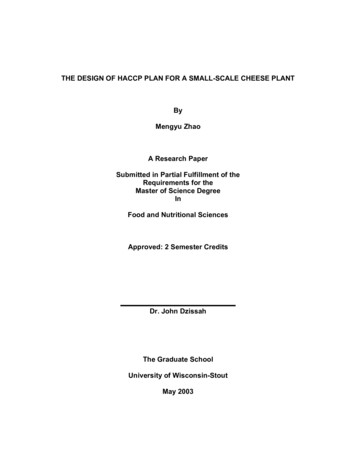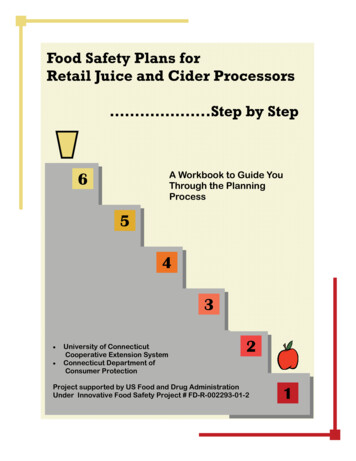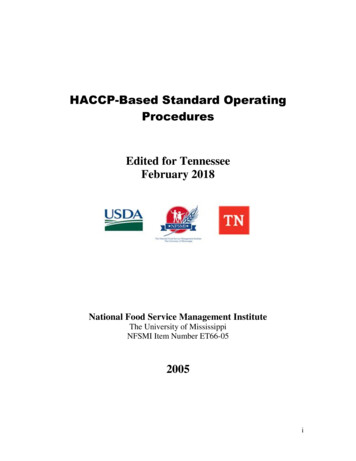
Transcription
THE DESIGN OF HACCP PLAN FOR A SMALL-SCALE CHEESE PLANTByMengyu ZhaoA Research PaperSubmitted in Partial Fulfillment of theRequirements for theMaster of Science DegreeInFood and Nutritional SciencesApproved: 2 Semester CreditsDr. John DzissahThe Graduate SchoolUniversity of Wisconsin-StoutMay 2003
iiThe Graduate SchoolUniversity of Wisconsin StoutMenomonie, WI 54751ABSTRACTZhao(Writer)Mengyu(Last Name)(First Name)(Initial)The Design of a HACCP Plan for a Small-scale Cheese Plant(Title)Food and Nutritional Sciences(Graduate Major)John Dzissah(Research Advisor)May, 2003(Date)53(No. of Pages)Publication Manual of the American Psychological Association (APA)(Name of Style Manual Used in this Study)Hazards analysis critical control points (HACCP) was developed as amanagement tool to provide a more structured approach to control identifiedhazards. It was first developed for the US manned space program to providepathogen-free food. This is now widely used in the food industry to ensure safefood was produced for the consumer. The purpose of this study is to modify the
iiigeneric HACCP model for cheese production based on actual conditions in thischeese plant. A specific model will be developed to boost the safety and qualityof cheese products in this plant.The preservation of raw milk during cheese production was consideredto be safe. However, the spread of some diseases by unsafe cheese productsreported makes it important to pay attention to the potential contamination incheese production which could cause hazards to human health. HACCP is mosteffective when it is plant-specific and product-specific. However, the genericHACCP models have not been applied in most of the small-scale cheese plants.To ensure the food safety in those plants, based on the generic HACCP modelthis study is pursued to design a specific HACCP model to be suitable in a smallscale cheese plant in western Wisconsin.
ivACKNOWLEDGEMENTSSincerely thank John Dzissah, my research director, for his professionaldirection and time to help me complete this studyIn addition, deep thanks to Michelle Stewart, the operations director inthe small-scale cheese plant, who provided the opportunity to work at their plant.Finally, I want to especially thank Stephanie Olsen, who helped toproofread my report.
vTABLE OF CONTENTSPageAbstract . iiList of Tables . viiList of Figures . viiCHAPTER ONE: INTRODUCTIONIntroduction . 1Statement of study . 3Needs for the study . 3Objectives . 3Significance of the study . 3Limitations of the study . 4FDA definitions . 4Other definitions . 5CHARPTER TWO: LITERATURE REVIEWIntroduction . 7Necessity for HACCP . 7History of HACCP . 8Advantages of HACCP . 10Developing of HACCP . 11Cheese and HACCP . 12Cheese making . 12
viHACCP on cheese . 16CHARPTER THREE: RESEARCH DESIGNIntroduction . 18Subject selection and description. 18Research method. 18Research approach. 19CHARPTER FOUR: REPORT OF FINDINGSIntroduction . 30Prerequisite program . 30Product description . 32List of ingredient and incoming material . 33Flow diagram . 34Hazards identification . 36Critical control points determination . 37HACCP control chart . 40CHARPTER FIVE: CONCLUTIONS AND RECOMMENDATIONSStatement of the problem . 42Method and procedures . 42Findings and conclusions . 42Recommendations . 43REFERENCE . 45
viiList of TablesTablesPage3.1 Production Description Form . 203.2 Raw Material and Potential Hazards Form . 213.3 Hazard Analysis Chart Form . 233.4 Process Decision Matrix Form . 273.5 HACCP Control Chart Form . 274.1 Production Description . 324.2 Hazards in Ingredient and Incoming Material Analysis Chart . 334.3 Material Decision Matrix . 344.4 Hazard Analysis Chart . 36-374.5 Process Step Decision Matrix . 39-404.6 HACCP Control Chart . 41List of FiguresFiguresPage3.1 CCP Raw Material Decision Tree . 223.2 CCP Process Decision Tree . 254.1 Flow Diagram . 35
1CHAPTER ONEIntroductionIntroductionHACCP is an acronym for the Hazard Analysis Critical Control Point. It isa system that was developed for assuring pathogen-free foods for the spaceprogram by the Pillsbury Company, the U.S. Army, and the National Aeronauticsand Space Administration (NASA) in the 1960s. HACCP was used in the foodprocessing industry for low-acid canned food production in the 1970s. It providesprecise process control measures for each step of the entire food manufacturingprocess. More recently, HACCP has been used in the meat and poultry industrythat is regulated by the United States Department of Agriculture (USDA). It isalso used in the seafood, juice and egg industries, which are regulated by theFood and Drug Administration (FDA). Now, the FDA is considering developingregulations for the dairy industry too (Bardic, 2001; Riswadkar, 2000).In dairy industries, HACCP is already being applied as a quality controlprogram, from fluid milk to ice cream to cheese. Cheese is a product thatpreserves raw milk. Due to the high acidity (low pH value) in the cheese-makingprocess, the pathogens in the milk are killed. However, in cheese manufacturing,problems associated with the presence of Listeria monocytogenes, Salmonellaenteritidis, Staphylococcus aureus, Escherichia coli and others have beendocumented. The traditional quality testing and inspection used in the cheesefactory is applied to the product once a problem presents itself. It is thus difficultto get 100% product inspection because of human error, obtaining sufficient
2samples and so on. HACCP was originally developed as a “zero defects”program and considered to be synonymous with food safety. It is astraightforward and logical system that uses preventative action to addresspotential microbiological, chemical and physical hazards that are identified in theprocess. HACCP is a science-based system used to ensure that food safetyhazards are controlled to prevent unsafe food from reaching the consumer(Bardic, 2001; Mortimore & Wallace 1997; Morris, 1997; IFST, 1998; Smukowski,1996). HACCP is applied to the following:1. Identify where hazards occurs along the process2. Establish a control and monitoring process3. Document all activities4. Ensure continuity in preventative measures(Mortimore & Wallace 1997)Most large cheese manufactory companies have implemented HACCPinto their quality control systems in order to produce safe and good qualityproduct. However, seldom do small-scale cheese plants implement their ownHACCP plans. HACCP is a plant-specific and product-specific quality system(Morris, 1997). To boost the quality of their cheese products, it would be of greatbenefit to small-scale cheese plants if they develop and implement HACCP planbased on their specific productions.
3Statement of the studyThe purpose of this study is to design a HACCP plan model for a smallscale cheese plant in western Wisconsin. The model is modified from severalgeneric HACCP models. This study started in the fall semester, 2002. Theresearcher worked in the plant, made observations of the plant environment, anddiscussed potential hazards with the cheese maker and the operation director inorder to develop the specific HACCP model.Needs for the studyThis study is specifically designed for a small-scale cheese plant thatwas just restructured and needs a better quality control system to producequality, safe cheese. The HACCP model can be applied in the plant to replacethe traditional inspection and quality procedure in order to prevent the hazards inthe cheese product.Objectives1. To evaluate the current methods of analysis on hazards that appearduring the processing and control procedures used in the plant.2. To set up a specific HACCP plan for this small-scale cheese plant.3. To document the HACCP plan in order to demonstrate theeffectiveness of its application.Significance of the studyA brief and specific HACCP plan model will be developed in this study. Itis the first HACCP plan to be developed based on the actual conditions in this
4small-scale cheese plant. It is a good start for a small plant, which has limitedresources and capital to perform the HACCP model as its quality control system.The small cheese maker is more acutely affected by the consequences ofunsafe product. The HACCP model in this study is planned to prevent hazardsthat could appear during the processing in this plant. It is a more efficient andcost effective quality control tool for the small cheese maker.Limitations of this studyThis study is limited to the researcher’s time and the working experiencein cheese plants.FDA Definitions (2001):HACCP (Hazard Analysis Critical Control Point): A system designed toidentify, evaluate, and control of the potential food safety hazards.HACCP Plan: The written document to describe the procedures based onthe principles of HACCP and specific conditions.Hazard: A biological, chemical, or physical agent that is reasonably likelyto cause illness or injury in the absence of its control.Contamination: exposure of food products to hazards, which can causeillness, disease, or even death.Prerequisite Programs: Procedures, including Good ManufacturingPractices that address operational conditions providing the foundation for theHACCP system.
5Critical Control Points (CCPs): points in the process where hazards canoccur and controls can be applied to prevent or eliminate a food safety hazard orreduce it to an acceptable level.Critical Limit: A maximum and/or minimum value to which a biological,chemical, or physical parameter must be controlled at a CCP to prevent,eliminate, or reduce to an acceptable level the occurrence of a food safetyhazard.Monitor: To conduct a planned sequence of observations ormeasurements to assess whether a CCP is under control and to produce anaccurate record for future use in verification.Corrective Action: Procedures followed when a deviation occurs.Verification: Those activities, other than monitoring, that determine thevalidity of the HACCP plan and that the system is operating according to theplan.Other DefinitionsGood Manufacturing Practice (GMP): GMP is part of quality assurancewhich ensures that products are consistently produced and controlled to thequality standards. It is based on the knowledge and skills throughout the foodsystem, from raw materials, through processing of the consumer products anddistribution.Laboratory Accreditation: laboratory’s quality system conforms to therequirements of an appropriate standard and of a laboratory’s technicalcompetence to perform specific tests or calibrations
6ISO 9000: ISO 9000 is a series of standards to define, establish, andmaintain an effective quality system for manufacturing and service industries.Statistical Process Control Techniques: Statistical process control (SPC)is scientific methods for analyzing data and keeping the process within certainboundaries.
7CHAPTER TWOLiterature ReviewIntroductionThis chapter will discuss the necessity for and the history of HACCP aswell as the studies of the application and principle of HACCP. It will conclude witha report of findings of the significance of HACCP on cheese processing.Necessity for HACCPAccording to a 1996 U.S. Dept. of Agriculture (USDA) report, “food-bornemicrobiological contamination in the U.S. causes an estimated 9,000 deaths and33 million human illnesses annually.” The cost of treating these human illnessesand the subsequent loss in productivity is estimated to be 9.3 to 12.9 billionannually (Riswadkar, 2000).Recent headlines have reported food safety problems. Such as, APDetroit reported: "Hot dogs blamed for Listeria outbreak" in June 1999; New YorkTimes reported: "12th death is linked to tainted meat at plant" on Jan. 27, 1999;and CNN reported: "Armed with E-coli horror stories, consumer groups demandsafer meat" on Nov. 10, 1999 (Riswadkar, 2000).Consumer expectations about food quality and safety have risen,prompting food processors to seek systems and programs that improve foodsafety.Traditional quality assurance programs and facility inspections haveproven to be inadequate in controlling many food-borne illnesses. Therefore,Food and Drug Administration (FDA), USDA and other food regulatory agencies
8are seeking alternative approaches that will effectively and comprehensivelyevaluate a food plant's ability to produce consistently safe and high-quality foods.(Riswadkar, 2000)The HACCP system is one such alternative, which focuses on identifyingand preventing hazards rather than relying on intermittent checks ofmanufacturing processes and random sampling (Riswadkar, 2000).History of HACCPHACCP was developed by the Pillsbury Company along with NASA in the1960s. It was originally developed as a microbiological safety system to ensurefood safety for astronauts. At that time most food safety and quality controlsystems were based on end product testing, which is an inefficient method due toproduct waste. Therefore, a preventative system needed to be developed to givea high level of food safety assurance (Bardic, 2001; Bennet & Steed, 1999;Mortimore & Wallace, 1997).The HACCP approach was based on the engineering system, Failure,Mode and Effect Analysis (FMEA). This system identified potential problems ateach operational stage and proposed solutions to such problems beforedeploying effective control mechanisms (Mortimore & Wallace, 1997).Like FMEA, HACCP looks for hazards, but in the interest of productsafety. Control and management systems are then implemented to ensure thatthe product is safe for the consumer (Mortimore & Wallace, 1997).Originally, HACCP was based on the following principles:
91. Comprehensive hazard analysis and risk assessment.2. Determination and identification of critical control points (CCPs).3. Monitoring of CCPs.(Riswadkar, 2000, P33-34)Subcommittees of both the National Conference on Food Protection andNational Academy of Sciences recommended that the HACCP approach beadopted by both the U.S. food industry and other regulatory agencies in 1986.This led to the formation of the National Advisory Committee on MicrobiologicalCriteria for Foods (NACMCF) in 1987. This committee expanded the HACCP’soriginal principle to include the following seven principles now widely accepted asthe standard (Riswadkar, 2000, P33-34):1. Conduct hazard analysis and risk assessment.2. Identify critical control points in food preparation.3. Establish critical limits for each CCP.4. Establish procedures for monitoring the CCPs.5. Establish corrective action protocol for each CCP.6. Establish procedures for effective recordkeeping.7. Establish procedures for an effective verification (audit).These principles allow safety and quality to be built into each step withinthe process rather than focusing on the final step, the finished product. Evenpotential consumer abuse and misuse is addressed by HACCP principles.A systematic hazard analysis is used to identify critical control points(CCPs) at each step of the process. These points must be controlled in order to
10ensure food safety and prevent food-borne illnesses. With HACCP in place, afood processor can identify and monitor specific food-borne hazards that aremicrobiological, chemical or physical in nature. Microbiological hazards arebacterial, viral, or enteric and parasitic organisms. Chemical hazards includenaturally occurring elements (such as mycotoxins from mold), toxic mushrooms,plant toxins and chemicals added during food processing (such as pesticideresidues, food additives and lubricants). Though physical hazards occur lessfrequently in food processing they do pose problems when fragments like glass,stone, or metal are found in the product (Riswadkar, 2000).Advantages of HACCPHACCP is a systematic and scientific program. Based on its proactiveand preventative model, it gives consumers more confidence in product safety. Itfocuses on identifying and preventing hazards from contaminated food byenabling the processor to focus on CCP’s. It prevents inefficiency associated withblanket sanitation measures. It permits more efficient and effective governmentoversight, primarily because the recordkeeping tracks compliance with foodsafety laws over a period rather than sporadic monitoring on any given day.Finally, HACCP also helps food companies compete more effectively in the worldmarket (FDA, 2001; Dillon and Griffith, 1995).Recently, the FDA (2001) established HACCP for the seafood and juiceindustries. In 1998, USDA established HACCP for meat and poultry processingplants. Most of these establishments were mandated to start using HACCP byJanuary 1999. Small-scale plants had until Jan. 25, 2000.
11The FDA (2001) is considering establishing the HACCP as the food safetystandard in other areas of the food industry, including both domestic andimported food products.To determine the feasibility of such regulations, the agency is alsoconducting pilot HACCP programs with volunteer food companies producingcheese, frozen dough, breakfast cereals, salad dressing, bread, flour and otherproducts (FDA, 2001).Developing of HACCPHACCP should be especially developed to each specific product and foreach process of production. Some prerequisite programs should be set up first,which help to simplify the critical control points in HACCP. Quality Audit (QA)/Quality Control (QC) programs, sanitation programs, microbiological analysis,preventative-maintenance programs, employee training programs, GoodManufacturing Practices (GMPs) and Standard Sanitation Operating Procedures(SSOPs) are all prerequisites to HACCP (Morris, 1997).The identification of CCP’s in raw materials is important for developingHACCP, since most of the hazards are brought in by raw materials. Many pointsin food processing can be considered control points, but few are CCPs. “CriticalControl Points should be established only at those points in a process where lackof control is likely to result in a potential safety hazard.” (Morris, 1997, n.p.).Since there are many controlled operations in food processing, these CCPs canbe critical points steps or procedures during food processing. For example:sanitation as a prerequisite program will get rid of some chemical hazards on the
12utensils. The goal of these CCPs is to ensure that food safety hazard can beprevented, controlled, reduced or eliminated. For example, the time-temperaturerelation in pasteurization is a CCP (Riswadkar, 2000).Another important area to consider is the Microbiological testing. Thistest is ineffective in monitoring CCPs because of the time required to obtainresults, even with the rapid 48-hour systems recently developed (Morris, 1997).Consequently, some specific temperature, time and pH controls have been usedin the cheese making process for a long time to control the quality of the product.Therefore, those chemical and physical check points can be used to monitor thecritical hazards.Cheese and HACCPAttention has been drawn to the hazards to human health due to thepotential presence of pathogenic bacteria from the raw milk used in cheeseproduction. Recommendations have been given for safe production of cheeseapplying Hazard Analysis Critical Control Point (HACCP) principles.A. Cheese MakingCheese making is the process of removing water, lactose and someminerals from milk to produce a concentrate of milk fat and protein. The essentialingredients for cheese are milk, rennet, starter cultures and salt. The semi-firmgel is formed by adding rennet that causes the milk proteins to aggregate at acertain pH; then, it is cut into small curds. Then, the whey (mostly water andlactose) begins to separate from the curds. Acid production by bacterial cultures
13is essential to aid in the expulsion of whey from the curd and largely determinesthe final cheese moisture, flavor and texture (Hill, 2000).According to several resources, the main procedures to make cheddarcheese are as follows (Hill, 2000; Macrae et.al, 1993; Jenkins, 1996; Potter,1995; Fox et al., 2000; Kosikowski and Mistry, 1997; Scott, 1986):1. PasteurizeMost cheese is produced from milk that has been pasteurized.Pasteurization is one of the major critical control points in the cheese makingprocess. It helps to increase health to the consumer by destroying the pathogenicmicro-organisms present in the raw milk. High-Temperature-Short-Time (HTST)pasteurization is widely used. This flow method system consists of heatingplates, a holding tube, a flow diversion valve, and time-temperature recordingcharts. This method heats the milk to 72oC for at least 15 seconds.2. Addition of the starter culture:Cultures are the prepared inoculate of bacteria, yeast and moulds. Theyhave two purposes in cheese making which are to develop acidity and topromote ripening. Lactic acid cultures contribute to both of these functions, whilenumerous special or secondary cultures are added to help with the secondfunction.The starters for cheddar are mesophilic homofermenative cultures ofLactococcus lactis subsp. Lactis and cremoris. There is generally a ripeningperiod of 30-60 min depending upon the type of starter added.
143. Protein coagulation:Casein is the major protein in milk. During cheese production, rennet, acoagulating enzyme, is stirred into the milk. Under certain acid condition, rennetthen separates the casein from the whey and causes the individual cells of thecasein to clump together to form the gel network.4. Cutting:Proper cutting is extremely important to both quality and yield. The smallcurd particles could be lost by the improper cutting and handling of the curd. Bothearly cutting when the curd is fragile and late cutting when the curd is brittlecause losses of particles. The curd is ready to cut if it breaks cleanly when a flatblade is inserted at 45o angle to the surface and then raised slowly. Curd sizehas a great influence on moisture retention, so the cutting wire should be chosencarefully.5. Cooking:The cooking and stirring will cause an increase in the acidity. Therefore,the moisture, lactose, acid, soluble minerals and salts, and whey proteins will beexpelled. After cutting, the curd is gently stirred in the whey, and the temperatureis raised from 30 to 38 C over a period of 45-60 min.6. Drainage:The whey is drained when the pH of the curd is 6.0. The curds areallowed to settle; a strainer is inserted, the exit gate valve is opened, and thegreenish colored whey is diverted to a storage tank.
157. Cheddaring:Cheddaring is used only for cheddar cheeses as a curd treatment toachieve a particular texture for milling the cheese. The curds are matted for 15minutes following complete whey removal. A longitudinal cut is made down themiddle of two trenched curd columns with a large bread knife. Horizontal columnsare then cut at intervals of approximately 25.4 centimeters (10 inches). The curdblocks are spaced at about 2.5 centimeters (1 inch) apart, allowed to rest for 15minutes and then turned over. This is repeated twice at 15 minute intervals withall loose curds swept under the blocks. Individual blocks are piled double andturned over every 15 minutes so that new surfaces are exposed. If necessary,the blocks are piled three high for the last 30 minutes.8. Milling:Milling is a process of reducing the size of cheddared curd into smallpieces so that salt can be applied. Milling is done when the pH 5.2-5.4 is reachedfor the draining whey.9. Salting:The purpose of salting is as follows: to inhibit the growth and activity ofpathogenic and food-poisoning microorganisms; inhibit the activity of variousenzymes in cheese; reduce the moisture of cheese; change cheese proteinswhich influence cheese texture and protein solubility; and affect cheese flavor.Cheddar cheese is salted with the dry salt. 1.5-2.0% salt is spread manually overthe milled curd.
1610. Hooping and pressing:The salted cheese was shaped into the metal hoops which are lined withmuslin cloth. During hooping, the curds are allowed to form a continuous mass.Pressing the mass helps to form loose curd particles into a compact mass andexpel whey. The cheese is pressed overnight with low pressure initially and thengradually increasing the pressure to 75 kPa. This is because initial high pressurecompresses the surface layer and traps moisture in the body of the cheese whichwould be undesirable.11. Ripening:Cheese ripening exposes the prepared cheese to certain environmentalconditions (temperature, humidity and so on) for several months to several yearsdepending on the cheese type. The purpose is to break down the proteins, lipidsand carbohydrates (acids and sugars) which releases flavor compounds andmodifies cheese texture. Cheddar cheese is ripened at 2-12 C for 3-12 months,depending on the maturity required in the final product. The cheese is then cutand packed in retail packs.B. HACCP on Cheese:HACCP principles have been written into the requirements of the UK FoodSafety (General Food Hygiene) Regulations 1995 and the Dairy Products(Hygiene) Regulations 1995. The Institute of Food Science and Technology(IFST) strongly supports: “the application of HACCP-based systems for cheesemanufacture at all stages 'from farm to fork'” (IFST, 1998, P119).
17For the consistently reliable production of microbiologically safe cheese,IFST considers the following measures important (1998, p.121):1. A HACCP-based risk assessment and Good Manufacturing Practiceshould be employed at all stages of production and handling, from thefarm to the consumer.2. For those products where a risk assessment indicates a hazard frompathogens in the raw milk, the milk should undergo full pasteurizationor a process of equivalent effect.Developing a HACCP plan for the small-scale cheese plant can bedifficult. Therefore, this study will pursue a brief HACCP plan based on the actualconditions in this plant.
18CHAPTER THREEResearch DesignIntroduction:This chapter includes a description of the subject that was selected, theresearch method and process that was used in this study and how this study wasapproached by introducing the HACCP recordkeeping forms.Subject selection and description:This study was conducted in a small-scale cheese plant (less than 10employees) in Wisconsin. This is an old plant which was being restructured toinclude an effective control system to boost product quality and productivity.The restructuring was aimed at expanding the company’s market.Consequently, the company pla
product. However, seldom do small-scale cheese plants implement their own HACCP plans. HACCP is a plant-specific and product-specific quality system (Morris, 1997). To boost the quality of their cheese products, it would be of great benefit to small-scale cheese plants if they develop and implement HACCP plan based on their specific productions.










